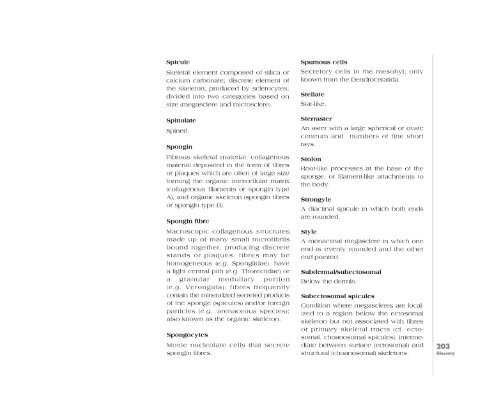Sponges of the New Caledonian lagoon - IRD
Sponges of the New Caledonian lagoon - IRD
Sponges of the New Caledonian lagoon - IRD
You also want an ePaper? Increase the reach of your titles
YUMPU automatically turns print PDFs into web optimized ePapers that Google loves.
spicule<br />
Skeletal element composed <strong>of</strong> silica or<br />
calcium carbonate; discrete element <strong>of</strong><br />
<strong>the</strong> skeleton, produced by sclerocytes;<br />
divided into two categories based on<br />
size (megasclere and microsclere).<br />
Spinulate<br />
Spined.<br />
Spongin<br />
Fibrous skeletal material; collagenous<br />
material deposited in <strong>the</strong> form <strong>of</strong> fibres<br />
or plaques which are <strong>of</strong>ten <strong>of</strong> large size<br />
forming <strong>the</strong> organic intercellular matrix<br />
(collagenous filaments or spongin type<br />
A), and organic skeleton (spongin fibres<br />
or spongin type B).<br />
spongin fibre<br />
Macroscopic collagenous structures<br />
made up <strong>of</strong> many small micr<strong>of</strong>ibrils<br />
bound toge<strong>the</strong>r, producing discrete<br />
stands or plaques; fibres may be<br />
homogeneous (e.g. Spongiidae), have<br />
a light central pith (e.g. Thorectidae) or<br />
a granular medullary portion<br />
(e.g. verongida); fibres frequently<br />
contain <strong>the</strong> mineralized secreted products<br />
<strong>of</strong> <strong>the</strong> sponge (spicules) and/or foreign<br />
particles (e.g. arenaceous species);<br />
also known as <strong>the</strong> organic skeleton.<br />
spongocytes<br />
Motile nucleolate cells that secrete<br />
spongin fibres.<br />
Spumous cells<br />
Secretory cells in <strong>the</strong> mesohyl; only<br />
known from <strong>the</strong> Dendroceratida.<br />
Stellate<br />
Star-like.<br />
Sterraster<br />
An aster with a large spherical or ovate<br />
centrum and numbers <strong>of</strong> fine short<br />
rays.<br />
Stolon<br />
Root-like processes at <strong>the</strong> base <strong>of</strong> <strong>the</strong><br />
sponge, or filament-like attachments to<br />
<strong>the</strong> body.<br />
Strongyle<br />
A diactinal spicule in which both ends<br />
are rounded.<br />
Style<br />
A monactinal megasclere in which one<br />
end is evenly rounded and <strong>the</strong> o<strong>the</strong>r<br />
end pointed.<br />
SubdermaVsubectosomal<br />
Below <strong>the</strong> dermis.<br />
Subectosomal spicules<br />
Condition where megascleres are localized<br />
to a region below <strong>the</strong> ectosomal<br />
skeleton but not associated with fibres<br />
or primary skeletal tracts (cf. ectosomal,<br />
choanosomal spicules); intermediate<br />
between surface (ectosomal) and<br />
structural (choanosomal) skeletons.<br />
203<br />
Glossary

















